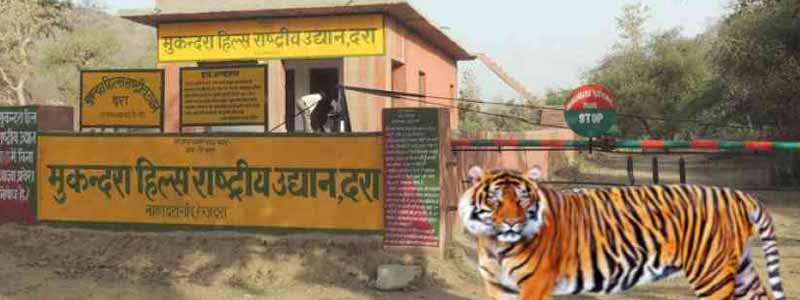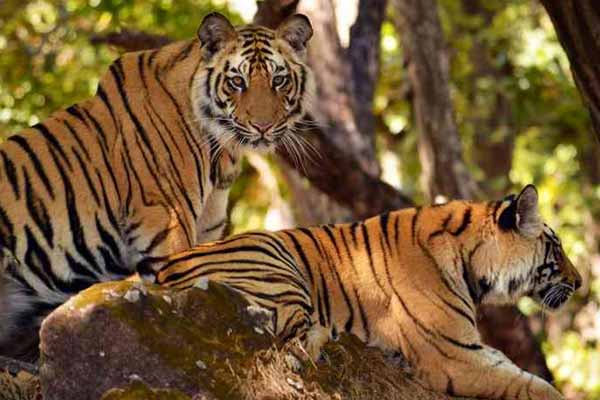Mukundara Hills National Park is the third Tiger Reserve in Rajasthan wildlife after Ranthambore and Sariska! Mukundara Hills Tiger Reserve is unfurled across four districts – Kota, Bundi, Chittorgarh and Jhalawar covering an area of 759 sq km in Hadoti region of Rajasthan. The core area of new tiger reserve is around 417 sq km and buffering zone covers around 343 sq km.
Earlier it was known as Mukundara Hills (Darrah) National Park. It is a combination of three wildlife sanctuaries namely Darrah wildlife sanctuary, Chambal wildlife sanctuary and Jaswant Sagar wildlife sanctuary.
Popularly known as Darrah wildlife Sanctuary, is just 50 km away from Kota. The name ‘Darrah’ means ‘pass’ in the local language that was derived by the localities as this place served as a pass during the wars by Marathas, Rajput’s and British. The beautiful park and scenic beauty are located and based between the mountains of Mukundra and Gagrola . Along the boundaries of the valley, four mystic rivers flow namely Ramzan, Ahu, Kali, and Chambal.
The tiger reserve was a hunting preserve which belonged to Maharaja of Mukundara Hills National Park. As a thickly forested tiger reserve, it lies along the southeastern border of Kota, Rajasthan.

History
The core area of Mukundara Hills National Park & Tiger Reserve is one of the oldest sanctuaries of India, popularly called as ‘Darrah Sanctuary’
Darrah was declared a Wildlife Sanctuary ( Protected Area ) in 1955.
Before Independence, it used to be the hunting protectorate of Kota state and was famous for its tigers, other big cats and deer wildlife tour packages.
It was declared as a National Park in 2004 and was given the name ‘Mukundra Hills ( Darrah ) National Park’ which was formed by combining three wildlife sanctuaries: Darrah Wildlife Sanctuary, Chambal Wildlife Sanctuary and Jawahar Sagar Wildlife Sanctuary.
In 2013, National Tiger Conservation Authority passed its approval and Rajasthan got its third Tiger Reserve after Ranthambore and Sariska. While being declared as a Mukundara Hills National Park failed to get a single tiger for many years.
Other Attractions at Mukundra Hills
The rich biodiversity of Mukundara Hills National Park Kota with the enthralling view of Chambal makes it different from the other Tiger Reserves of its kind.
- MIGRATORY BIRDS
Mukundara Hills National Park Kota hosts a variety of migratory birds in winter including gray pelicans, Bar Headed Goose, Ruddy Shelduck, Gray Lag Goose along with the Pied cuckoo, Jacobin cuckoo, Eurasian cuckoo and many more.
If you are into bird watching, then this place is a true heaven for you!
- WATERFALLS
Waterfalls greet their visitors with bundles of joy and serenity along with thrill and amazement.
The beauty of a waterfall is impossible to convey in a mere combination of words.
Some of the breathtaking Waterfalls which you can find here are: Geparnath Waterfall, Padajhar Waterfall and Garadia Waterfall.
- WATER SAFARI
This is one of the most exciting features of MHTR. Mukundra is perhaps the first tiger Reserves to host both water Safari and Jungle Safari in its stretches.
Aren’t you excited to be dabbed by some cool splashes of Chambal on your visit to Mukundara Hills National Park? wink wink
- FLORA AND FAUNA
The Mukundara Hills National Park Kota has gently sloping hills covered with ‘Dhok’ trees and a mixed jungle of sheesam, belimali, arjun, ficus, khair, gurjan and salar. Sambhar, cheetal, chinkara, Neelgai and four-horned antelope are the true deer, gazelle and antelope found in the reserve. Leopard are common and so are the wolf, jackal, hyena and sloth bear.
Paradise flycatcher, Golden oriole, a variety of woodpeckers, flycatchers, doves, babblers, mynas, sandgrouse, nightjars, eagles, owls and vultures form the most important and conservation dependent avian species of Mukandara.
The lakes and ponds within the Reserve support a wide variety of migratory and resident waterbirds, including geese
and ducks.
- BREATHTAKING VIEWS
With the azure streams of water, the region is a blessing not only for the wildlife photographers but also for those who love capturing the adorable and mesmerizing sites of nature.
Visit MHTR to lens some of the finest and most picturesque landscapes found in nature.
Best Time to Visit
Visitors can visit the national Park throughout the year, but the best time to visit is between February to May. The sanctuary is open all through the year except between 1st July to 30th September Mukundara Hills National Park.
The sanctuary is open for the visitors from 10 am to 5 pm every day. Tourists have to take a signed permission from the local forest ranger in order to visit the sanctuary. The visitors can explore the wild side of Rajasthan during this time enjoying the comfortable weather.
How to Reach
By air – The nearest airport from Mukundara Hills Tiger Reserve (Darrah) National Park is Udaipur which is around 300 km from Kota.
By Rail – Nearest railway station is Kota railway station located about 50 km from the Mukundra Hills (Darrah) National Park.
By road – The nearest bus station to Darrah is the bus station in Kota at the Bundi road close to the eastern shore of the Chambal River. This station provides good services to all the major cities of Rajasthan like Ajmer, Chittorgarh, Jaipur, Udaipur, etc.
